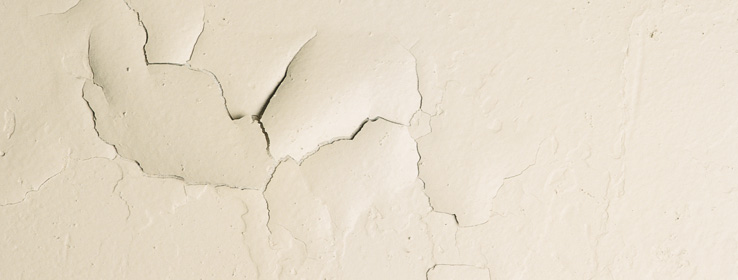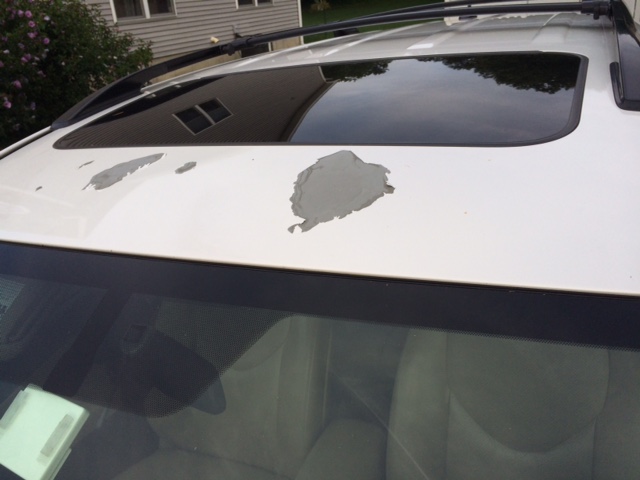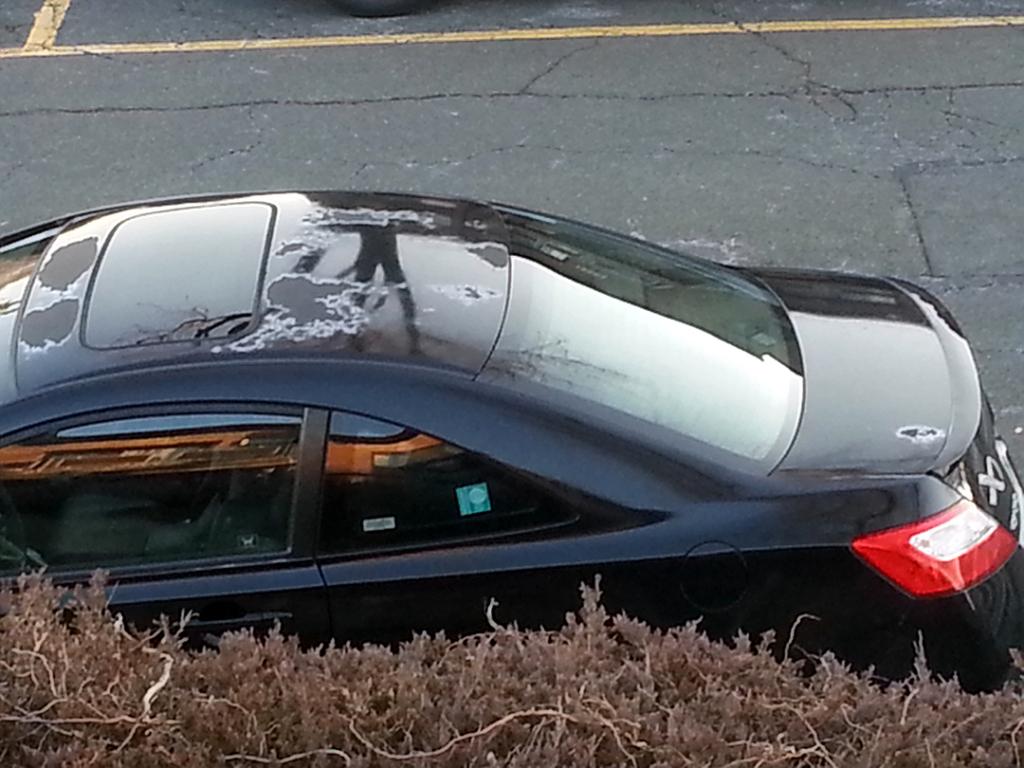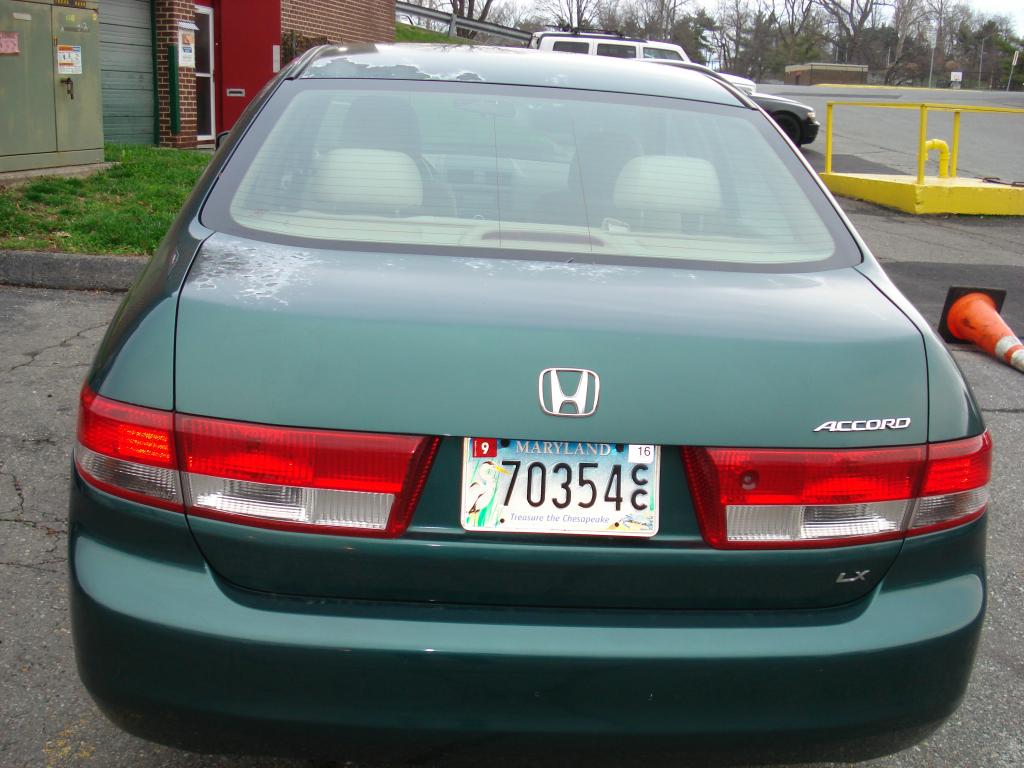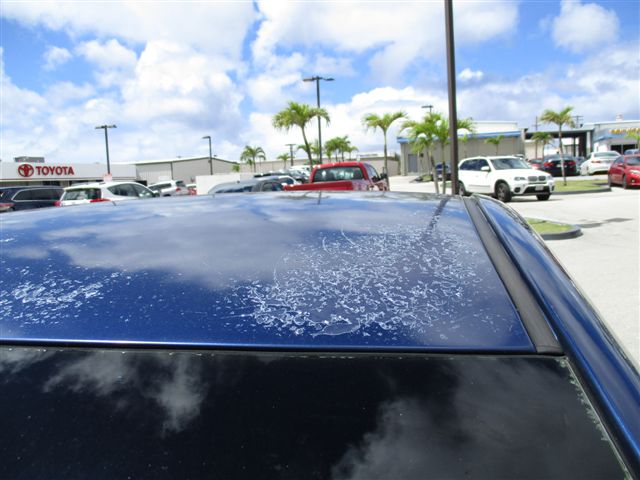Your car's paint job plays a big role in keeping your car looking great and seeming new. As the year's pass, it's likely that some of that like-new color finish will begin to diminish. In addition to scrapes and scratches, a common malady that befalls car paint jobs is noting paint peeling off car exteriors. If you have car paint peeling or bubbling, then you should consider repairing the damage promptly by finding reliable auto painting in Pittsburgh. Peeling is the pulling away of the full paint job, base color and clear coat, from the panel underneath. For peeling to occur, the wear and tear on your vehicle has to be considerable.
General Motors and Chrysler vehicles had a past issue stemming from not sealing their e-coat before applying the colored base coat. E-coat is for corrosion protection but it is susceptible to Ultraviolet sun rays causing breakdown. Without a sealer being applied, the UV rays penetrated through the base coat and disrupted the e-coat layer, ultimately leading to the paint peeling. This same issue may occur at the body shop if the shop does not properly seal the new part before applying colored base coat. To fix a peeling clear coat on your car, start by scrubbing the peeling area with 1000-grit sandpaper to get rid of the damaged coat.
Then, soak 2000-grit sandpaper in water for an hour before sanding around the damage to blend the repair area with the clear coat. Once you've sanded your car, clean the space with an alcohol-based cleaner, like glass cleaner, and scuff it with a fine grit, woven scuffing pad. After you've cleaned the area, tape around it with masking tape to mark out your working space. Next, spray an aerosol can of clear coat onto the surface. Let it dry for 5 minutes, then spray on a second coat. To finish off, remove the masking tape, then lightly go over the area with 2000-grit sandpaper to blend your new coat with the old one.
An illustration of what areas of a car's painted exterior can be safely polished/paint corrected, and what should be left to the professionals. The issue with correctly removing spot-damaged clear coat, is that for as simple as it sounds, the sanding process tends to be a painstakingly technical, tedious task. A solid understanding of paint conditions, sandpaper grit progression, and appropriate levels of applied force all must be weighed.
This is the stage of clear coat correction where most people will fuck-up and be forced to phone a friend, family member, or local body repair shop for assistance. Spring is a great time to repaint, says Mark T. Knaebe, a chemist at the Forest Products Laboratory in Madison, Wisconsin. He recommends starting with a quick test to determine the extent of the work. First, choose an inconspicuous place where the paint is worst. Clean the surface, let it dry and paint a small patch.
The next day, press on a Band-Aid and then quickly pull it off. If the tape is clean, it's safe to repaint after scrubbing the whole house. If the tape pulls off all the paint down to bare wood, the house needs to be stripped before it's repainted. If just new paint comes off, the old paint is too chalky and you'll have to coat the whole house with an oil primer first. Sand all bare wood and exposed paint edges or the new paint will be thin there and will chip in no time.
Scrub the walls with water and kill any mildew by using a solution of one par household bleach to three parts water. The first layer is the primer which helps the paint adhere to the car's surface, the second layer is the paint, and the final layer is a top coat that helps to seal the paint. A car's paint starts to peel if any of these layers fail to stick together. This can be caused by improper application of each layer or damages to the paint caused by scratches that expose the layers to other factors that cause the paint to peel off. Full sanding and repainting are required for such problems to ensure that the paint is properly sealed. If you notice car paint peeling, it could be due to a number of factors.
Typically, the culprit is prolonged exposure to the sun's ultraviolet rays or a poor paint job. When this occurs, large and small flakes of paint can peel off the vehicle. Scratches and dings can also cause the paint underneath it to peel. William C. Feist thinks he knows why this happens and how to deal with peeling paint.
In the United States, almost all paint companies turn to Rohm & Haas and its Paint Quality Institute in Spring House, Pennsylvania, near Philadelphia. There, in a six-acre field draped with two miles of odd-looking fences, 25,000 paint samples are in a contest with time, weather and the sun. You still love your older car, but it's starting to look its age. The paint job's glossy shine might be marred by bubbles and blisters of the clear coat finish.
This is known as delamination, and the best fix for widespread cases is a pricey repainting job. Or, if you have some experience with automotive painting, you can use professional tools like a compressed air gun to apply new clear coat. However, if the peeling is limited in scope—for instance, spots on the hood or near the wheels—making spot repairs with an aerosol spray can is a manageable DIY project. When your car's exterior is experiencing unsightly paint peeling issues, take it to a nearby auto body shop featured within the nationwide Carwise network. For example, if you were to have a car repainted right after leaving the factory and the paint didn't have enough time to cure, it could lead to paint peeling off car. The DIY products on the market can do a nice job of replacing bubbling and peeling clear coat spots.
However, a close inspection will always reveal differences between the original paint job and the repaired areas. They may be able to repaint a single section, like the hood, or it may be necessary to repaint the entire car. To avoid future painting, only guaranteed protection can be acquired through removal of coat down to the primer layer. You should remove the paint from an area of 5 centimeters around the infected area, even though you cannot see any signs of peeling here. Removing paint from the extended portion will prohibit any future damage.
Once the bare metal becomes smooth and paint free, prepare to replace it with a new primer, paint and clear coat. While you may not be able to totally avoid natural exposure or road damage, there are steps you can take to avoid paint peeling. When your car needs paintwork done, be sure to choose a shop with a reputation for reliable auto painting in Pittsburgh to ensure you get a quality finish. If you do notice any areas that are starting to peel or where road damage has occurred, take it in for a spot touch up immediately.
This can prevent a small car paint peeling problem from becoming a big one. Getting your vehicle fixed after an accident can be a burden. Almost all repairs to the body of the vehicle will require paint application.
Vehicle owners often ask how the auto body shop will match the color of the paint on their vehicle. This can be one of the most challenging parts of auto body repair, and is essential for any successful body shop. At the assembly plant, your vehicle was painted along with a number of others from a paint formula that was mixed and prepared for those vehicles that day.
Why Is The Paint Chipping Off My Car There are many variables affecting the color tones and hue of that particular mixture. Although, paint application equipment is cleaned, the previous color formula pigments will carry-over into the next formula color. Paint ingredient suppliers have slight variations in their pigments, and material cost drives frequent supplier changes. During the application process, humidity, application pressure, nozzle size, distance and angle to panel influence how the dried paint will appear. Body paint matching a vehicle is a skill that not all auto body shops can accurately achieve.
Luckily, Ray's Automotive has years of experience color matching vehicles . Peeling, flaky paintwork occurs when one of the three layers coating the car's bodywork is damaged, often by a minor scratch or chip. There are a lot of reasons as to why a car's paint peels off. A lot of times if the car has been repainted, the painter will not prep and primer the car properly, causing the paint to feel at a later date. There could have been a powerful and harmful solvent spilled on the hood.
The sun and harmful UV rays also cause a serious problem. The photo above shows an extreme condition of paint peeling away. I feel that this was caused mostly by neglect, the harmful UV rays from the sun, or possibly a bad job of repainting. Now, I've had the chance to paint cars in a professional booth in the past, but I am far from a professional paint and body guy. Yet, when the job was done, I was impressed at how well this aerosol can laid paint. Even though there wasn't any wind on the day I painted, I still used pieces of cardboard to make it easier to paint and limit overspray hitting nearby cars.
As you can see in the image above, the result turned out great with the new paint perfectly blended into the old paint to avoid any obvious lines or shade differences. You take much pride in your car's appearance, and wash, wax and detail it faithfully. In fact, you even picked up some touch-up paint, and have been applying it to rock chips and scratches when they appear. But recently you've noticed some small areas on the front bumper and hood where the paint is starting to peel, and you're concerned. Even when keeping a car's painted surfaces detailed, certain factors can commonly cause paint peeling, or "delamination".
Left unchecked, delamination will ultimately decrease your vehicle's curb appeal and resale value. To guarantee complete protection against future peeling, you need to remove each coat down to the primer layer. The bare metal should be smooth and paint free, ready to be restored by a new coat of primer, paint and clear-coat. In the event the bare metal layer under the paint is also exposed, rust could also form, which will only increase the amount of time and money that must go into the repair. At the first sign of damage, take your vehicle to an auto body repair shop so you can preserve your car for as long as possible. Once your car is clean and dry and free of any bonded contaminants, it's time to lay down a protective barrier to block UV rays.
This is the step to preventing oxidation and peeling. For preventative maintenance, we recommend Hybrid Solutions Pro Flex Wax or Hybrid Solutions Pro To the Max Wax. With the incredible performance of pure graphene, both of these are at the cutting-edge of car wax performance. Or, if your car needs some paint correction from light scratches and swirls, we recommend an all-in-one polish and wax product like Hybrid Solutions Ceramic Polish & Wax.
You can prevent your clear coat from ever peeling and save yourself thousands of dollars by adopting some routine car care. Regularly washing your car is one of the most important things you can do to preserve its beautiful finish. We recommend a good car wash soap like M.A.X. Power Car Wash, a wash bucket and Grit Guard, a microfiber wash mitt and a few microfiber towels for drying. Not only will you remove harmful soils and contaminants from your car, but you'll also have the opportunity to see what's going on with your paint and clear coat. By paying attention and responding in kind, you'll avoid oxidized or peeling clear coat. Unfortunately, there's no way to restore a clear coat once it has begun peeling.
You'll need to have an auto body shop strip and repaint your car. If your clear coat has been neglected badly enough to peel in some areas, you'll still need to have the entire car repainted so that the color and finish match throughout. Be prepared for a hefty, but necessary bill if you intend to keep your car. The damage will only get worse until you address it, so it's best to bite the bullet and do it soon. I used a damp cloth to get most of the dirt and dust off the area I needed to paint, and then I prepped for paint and primer using the surface prep solvent.
I then taped off areas I didn't want oversprayed including the glass, weather stripping and roof rack rails, and I also let plenty of unmasked painted area to blend the paint. Once the primer had dried, I went over this area with a 600 grit sand paper to prepare for basecoat. Wash it frequently using non-abrasive cloths to prevent the dirt from building up and finish the job with a good quality wax. Use a cleaning product designed for washing cars, not household dishwashing liquid or similar, because it can damage clear coat. Some people advise that you keep clear of automated car washes because those rotating nylon brushes can damage clear coat, as can high pressure water jets.
The primer, which is the base layer, protects the underlying metal. The paint is the color coat, and it serves as a protective shell that shields the paint from scratches, oxidization, and helps maintain the paint's luster. Car paint peeling, AKA de-lamination, happens when one of the underlying layers stops sticking to the surface under it and comes undone. If a car is not properly protected from the sun and other elements that get in contact with its surface, the paint will eventually start chalking.
Chalking is a white discoloration on the car's paint which occurs when the pigments start fading due to the lack of protective coating. This can be prevented by regularly washing, waxing and polishing your car. While there are numerous other causes of clear coat peel, the following three offenders are the most common causes behind peeling paint jobs.
On top of the base color of your paint is a protective clear coat. If you spot an area where the clear coat is peeling off of your car, that is delamination. Once this begins, it compromises the clear coat in the surrounding area which will allow it to continue to spread further and further. The issue may have started at the factory with too little clear coat being applied. At home, exposure of the vehicle to bird sap or bird excrement are notorious for disrupting the clear coat if left to dry on the vehicle. This is usually true if a vehicle has already been repainted since leaving the factory, though it can happen at the auto manufacturer.
Rain also plays a significant role in peeling car paint. Heavy rain can wash away protective wax that is applied on top of the clear coat. When water penetrates the surface of your car, it can cause the color to fade, metal parts to corrode, and will create an ideal condition for rusting. The first thing you can do to address a car's paint peeling is to consult an autobody shop. The pros will be able to look at the peeling area to determine how much work is needed and the costs for the job. Another less expensive option is to do the work yourself.
You can use paint peeling repair kits made just for vehicles. However, unless you know what you are doing, the work may not turn out as good. All get compromised by a deep rock chip, ding, or scratch. Once that occurs, moisture, road salt, and other contaminants begin working their way through the coatings, starting the delamination process.
Even a small chip in the clear coat can facilitate serious paint peeling when the area is exposed to additional external forces like high-pressure washing or direct sunlight. A shiny and pristine paint job on your car is about more than just looking good on the road, it protects your car, too. If you have paint peeling off car surfaces, you need trustworthy auto painting in Pittsburgh today. A little touch-up now saves a big repair in the future. As the years pass by, you may start noticing several problems on your car's mechanism and also the paint as it starts to wear off. The high-temperature and humidity in the area can take a toll on your car's paint job and lead to its discoloration and fading.
While constant washing and waxing may help prevent your car's paint from wearing out, there are conditions where these practices can't help your car's paint issues. Your clear coat starts to peel after the sun's UV rays penetrate through the clear coat and start attacking the bond between the color coat of paint and the clear coat on top. Typically, this happens because the body panels of your car expand and contract ever-so-slightly in hot and cold temperatures. Eventually, after this happens over and over again, year after year, the clear coat loses some of its elasticity and starts to craze and crack.
